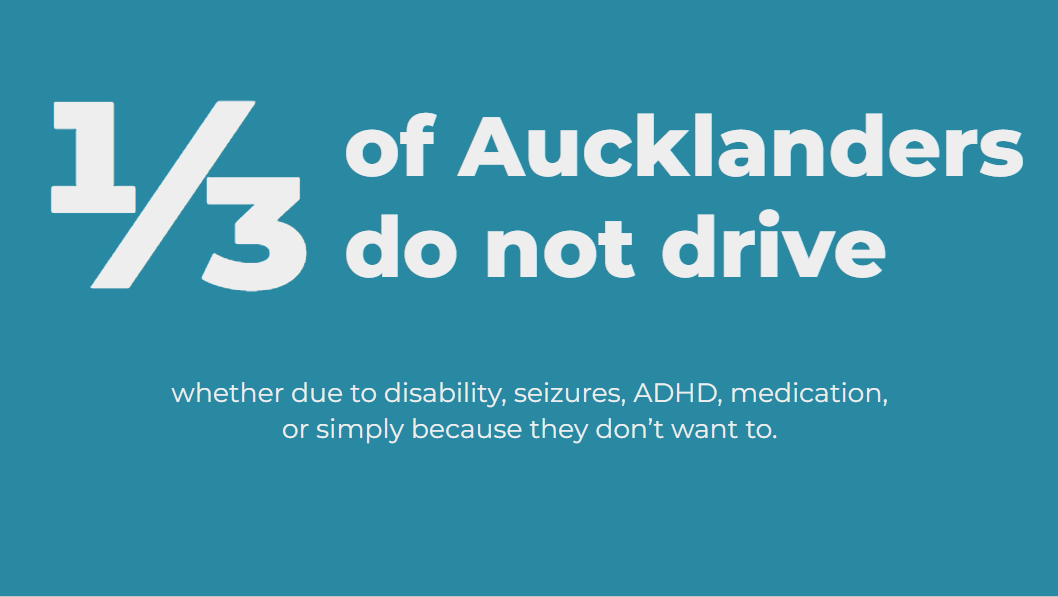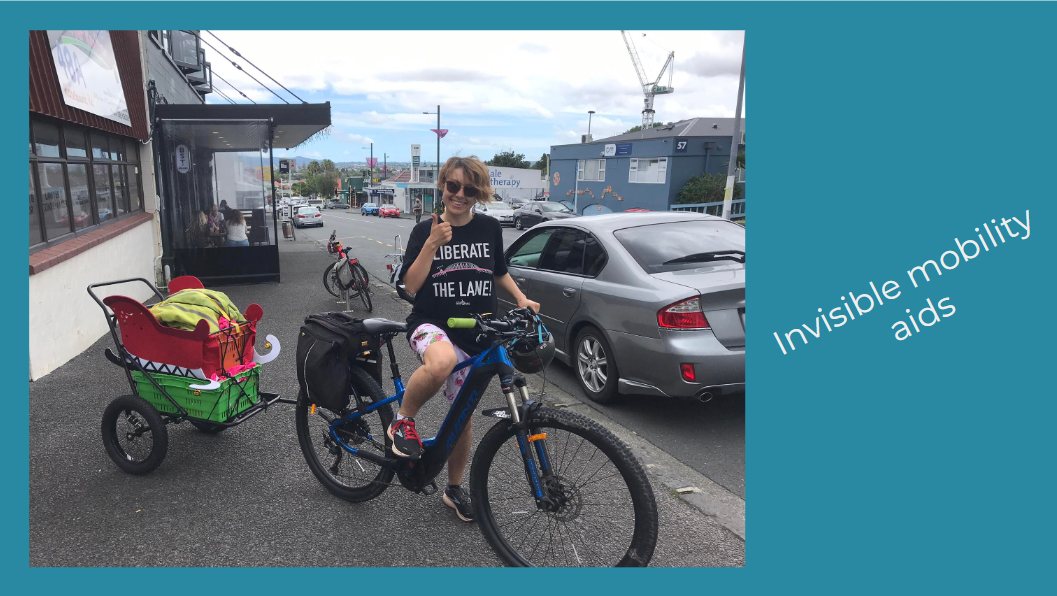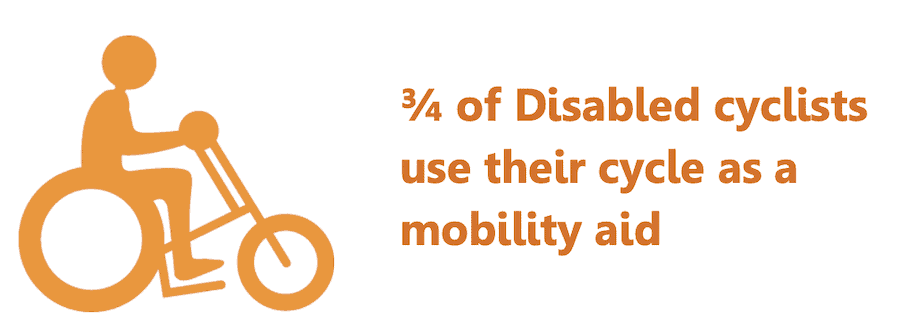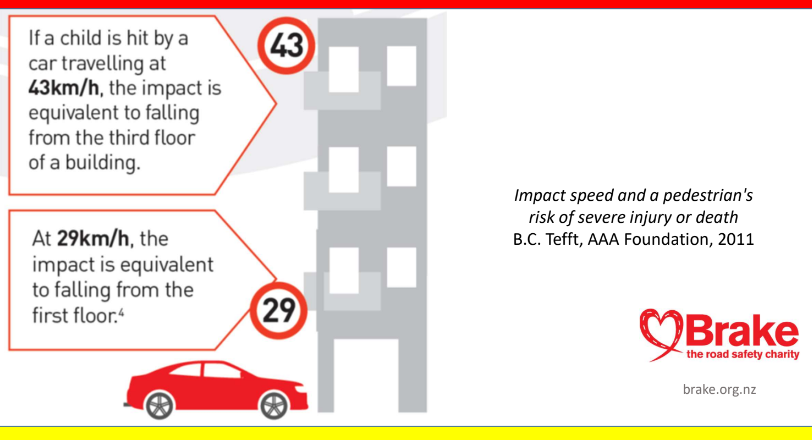Bike Auckland, Brake, and the Australasian College of Road Safety all presented to the Auckland Council Transport and Infrastructure Committee Meeting to urge the Council to oppose the Land Transport Rule: Setting of Speed Limits Rule 2024 (Speed Rule) which would impose blanket speed limit increases around our schools.
We’re very pleased to let you know that the Auckland Council maintained its commitment to keeping tamariki (children) safe and voted to formally oppose the Speed Rule. The Central Government will still have the final say on how they proceed with the Speed Rule – and it’s important they hear from you by midnight on July 11. Check out our quickfire guide for more information and have your say here.
This article includes the key points of the presentations as well as the Auckland Council decision. You can read the whole thing – or skip to the section you are most interested in.
Skip to….
- Video of the presentations
- Bike Auckland – Safe Speeds for an Accessible Transport Network
- Brake – The Road Safety Charity
- The Australasian College of Road Safety
- Auckland Council discussion and decision
Why Safe Speeds?
- making the street safer for everyone who uses it, drivers included
- getting more people walking and cycling from A to B
- increasing the accessibility of the street
- making the air cleaner
- making streets quieter and more pleasant
- increasing local community connection
All while adding only a negligible 15 seconds to the average car journey.
Which is why we are horrified that Minister Simeon Brown is trying to impose blanket speed limit increases on our communities with the Land Transport Rule: Setting of Speed Limits Rule 2024 (referred to as the “Speed Rule” for short).
It’s important the Central Government hears from all of us how harmful their proposal will be, and how much we love our 30km/hr streets.
Transport and Infrastructure Committee, July 4 2024
On July 4th, Bike Auckland, Brake, and the Australasian College of Road Safety each presented to the Auckland Council Transport and Infrastructure Committee Meeting urging the Council to oppose the Land Transport Rule: Setting of Speed Limits Rule 2024 (Speed Rule). The video below includes their 3 different presentations. You can read on for their key points, or skip to the end for Auckland Council’s decision.
Bike Auckland – An Accessible Transport Network
Skip to 19.46 in the video of the Transport and Infrastructure Committee Meeting
Our Chief Biking Officer Fiáin d’Leafy focused their presentation on accessibility, how bikes can increase mobility for some people, and how 30km/hr streets are a key part of creating an accessible transport network and realising the vision of the Aotearoa NZ Disability Strategy.

“1 out of 3 Aucklanders do not drive. And for some of these people – and for some of the people who currently are driving – a bike will be their best mode of transport.” Fiáin begins

“For me, my bike is my best mode of transport. It’s an E-bike. I get joint flare ups and sometimes it’s painful for me to walk. But I can still ride my bike to where I need to go, keeping me active, independent, and engaged in life.” Fiáin says their bike is an invisible mobility aid, and that many others who find walking painful or difficult can be given greater mobility and independence by a bike.

But, crucially, the transport network needs to be safe and accessible for most people to feel they have the choice to ride a bike.
The Vision of the Aotearoa New Zealand Disability Strategy is that…
“New Zealand is a non-disabling society – a place where disabled people have an equal opportunity to achieve their goals and aspirations, and all of New Zealand works together to make this happen.”
Bike Auckland wants Tāmaki Makaurau Auckland to have a non-disabling, accessible transport network, as a key part of achieving that vision.
“Currently we have an inaccessible transport network” Fiáin says, “some people are unable to complete their journeys and are forced to stay home because the transport network is inaccessible for them. This leads to increased loneliness, isolation, depression, and difficulty getting work because they can’t reliably get there. This has an affect on the communities around them. But, if we make our transport accessible, including safe and accessible to ride a bike, people will have more work options, better mental health outcomes, and be able to participate more in life. And this has a ripple effect of enabling some of their whānau, friends, and caregivers to get out and about by bike too.”
“30 is this magical number. It not only makes streets significantly safer, it makes the traffic noise quieter which makes the street feel more pleasant and attractive to walk and ride a bike. It feels safer so people start to walk and cycle more.” Fiáin says 30km/hr speeds is one of the most affordable ways to make streets become more accessible for a wider range of ages and abilities to move around in active ways. Of course, this is also key for reducing emissions from transport.

“We’ve seen this already in Tāmaki Makaurau Auckland, when speeds were reduced to 30km/hr as part of the Residential Speed Programme. People reported feeling safer and began to walk and cycle more. In Papakura, nearly half of the residents started to walk, cycle, or scooter more often.”

Fiáin d’Leafy brings it back to the Speed Rule “of course, this is relevant now because of the The Land Transport Rule: Setting of Speed Limits Rule 2024. This Rule will make us lose the accessibility and safety we currently have – and make it impossible to deliver what we have committed to. Bike Auckland urges you to protect accessibility and safety by opposing the Land Transport Rule: Setting of Speed Limits Rule 2024.
So that we can
– continue enjoying our existing 30km speed areas,
– deliver Katoa Ka Ora; Auckland’s Speed Management Plan which has been extensively consulted and is overwhelmingly supported, by the communities it will directly effect,
– and so that we can work towards that accessible transport network that we so desperately need.”
Brake – the Road Safety Charity
Skip to 10.07 in the video of the Transport and Infrastructure Committee
Caroline from Brake shared the story of Michelle who was hit by a car on Mt Eden Road while crossing the road in 2013. She was seriously injured and underwent major surgery, has undergone several surgeries in the last 11 years, including another major surgery last year. She will be on ACC for the rest of her life. The crash that she was in was not the result of reckless driving, or substance use. It was the result of someone who made a mistake.

2 out of 3 fatal and serious crashes in Tāmaki Makaurau Auckland do not involve reckless behaviour. They are the result of people making mistakes. We all make mistakes, but mistakes made driving a fast moving vehicle can have dire consequences. Driving at a speed of 30km/hr allows for a much faster reaction time, and shorter stopping distance, significantly reducing the likelihood of someone being killed or seriously injured, and saving drivers from having to live with the psychological trauma of accidentally killing or seriously injuring another person.
Brake is concerned that the Rule would not allow for 30km/hr speed limits despite the significant amount of evidence showing that where speed limits have been lowered the severity and frequency of crashes has also decreased. “There is a significant difference in the impact and survivability of a crash at 30km/hr compared to 50km/hr.”

Caroline says the draft Speed Rule doesn’t take into account the many different road environments and school set ups across Tāmaki Makaurau Auckland. Many of these require students to move across the road space throughout the day. Some have ‘split campuses’ which require students to cross the road to reach other classes. Others have unusual start and end times, such as childcare centres, or facilities which are used heavily by students in evenings and weekends. These unique circumstances had already been taken into account through consultations and Katoa Ka Ora but would not be taken into account with this blanket Speed Rule.

Brake are also concerned that reverting to variable speed limits (from permanent 30km/hr speeds) will make roads less safe.
“6 time more deaths and serious injuries are prevented by permanent 30km/hr speeds compared to variable speed limits.” Caroline says permanent 30km/hr speed limits also help make the street feel safer, encouraging more walking and cycling. “If parents don’t feel it’s safe they will drive their children to school, putting more traffic on the roads and creating more congestion”

Tāmaki Makaurau Auckland has changed a lot in the last 4 years and we need speed limits to match our road conditions. One particularly alarming example is Flat Bush School Road in South Auckland which currently has a 50km/hr speed limit, but was 100km/hr prior to 2020. The area has been a focus of development in the last 4 years and it has become increasingly residential. Under the draft Speed Rule it appears it would be forced back to the massively unsafe speed of 100km/hr.

Caroline says children in particular are at risk. Their brains are still developing so they cannot assess risk the way that adults can. They cannot accurately judge the speed of traffic going over 30km/hr so they may think it’s safe to cross when it isn’t. And if they’re hit by a vehicle they are more likely to suffer serious head and neck injuries because of where the impact is.
“We need to keep lower speed limits around schools and communities, and be able to implement more 30km/hr limits… This will result in not only safety benefits, but also health, environment, and economic benefits for us all”
The Australasian College of Road Safety
Skip to 28.29 in the video of the Transport and Infrastructure Committee Meeting
Dr Hamish Mackie, a transport researcher, and Paul Durden, a technical director with Abley and co-chair of the Aotearoa NZ chapter of the College. The College includes around 1000 members including experts in all areas of road safety including health, and policy. Their purpose is to support their members who represent areas of road safety, and their vision is the elimination of fatal and serious injury for all road users.
Their policy principles include
– We should prevent all fatal and serious injury on our roads
– The road traffic system must be made safe for all road users
– System designers should aim to prevent human error and mitigate its consequences
– Life and health are not exchangeable for other benefits in society
“We need to use survivable speeds. These 30km/hr speed limits which we have been implementing are super important. Above that pedestrians and cyclists will be killed or seriously hurt. There’s overwhelming evidence globally that implemented 30km/hr speeds in cities is leading to about a 30 – 40% reduction of deaths and serious injuries… Correspondingly, if we reverse these 30km/hr speed limits we can expect to see increases of trauma of those sorts of magnitudes” Dr Hamish Mackie says it’s really important to make sure the speed limits make sense to people, and that the look and feel is appropriate, and consistent across the network.
Paul Durden says that the College is concerned that the Rule does not allow provision for 30km/hr speeds to be set in the future. For example any urban street would need to be 50km/hr except where there are high levels of pedestrian or cycling activity, in which case it could be 40km/hr.
Dr Hamish Mackie says the Speed Rule as currently written would increase harm.
“There’s no real evidence that an increase in speed limits increases productivity, that’s more about congestion. […] Overall the evidence suggests we need to be improving and building on the current approach as opposed to reversing it.”
Auckland Council
Auckland Transport put together a draft submission on the Speed Rule on Auckland Council’s behalf. It was based on the current policy and strategic direction established by Auckland Council and Auckland Transport. You can see their draft suggestions here. While the draft submission already largely opposed the Speed Rule, it included “partially support” for Proposal 3: Require variable speed limits outside of school gates.

This particular section became the subject of great discussion for the Auckland Council Transport and Infrastructure Committee (which is comprised of all the Auckland Councillors and two Independent Māori Statutory Board members).
The Auckland Transport staff said that speed reversals (raising speeds) and implementing variable speeds by schools could cost Auckland $12 million. The Central Government has set aside some money towards speed reversals but it’s unclear what portion they would cover for Local and Regional Councils.
Cr Shane Henderson put forward an amendment to oppose ‘Proposal 3: Require variable speed limits outside of school gates’. Cr Henderson said this was on the grounds of safety, economics, and good governance. He continued into this absolute banger of a speech (which you can watch from 58.40):
“The governments proposal seeks […] to make a change that will, by definition, make our school areas less safe. I don’t really know why we would do that when Auckland has the 4th worse safety record in the Western world, and why we would do that in areas where lots of vulnerable Aucklanders use all the time. […]
I’m asking you to resist attempts to make that even worse and to resist changes that would put Aucklanders at risk. […]
We were advised today that it would be a negative BCR to make these variable changes. Whereas to do what we are doing now […] it’s a BCR of 3.6. […]
Fixed permanent signs also save 180 or more Aucklanders from death or injury. The Government proposal cuts that down to 29. Right?
Are we going to give up 150 lives for that? 150 people injured and maimed for that? All this for the gain of a couple of seconds of travel time. A couple of seconds. The time it took to clear my throat. […]
This doesn’t add up financially or in terms of safety. […] For this privilege, so called, we are going to be asked to put up 12 million dollars. […]
At the end of the day we are the road controlling authority. […]
When I was the local board Chair one of the first things we did, we put in one of the first slow speed zone in Auckland in Te Atatū South. And to this day, I hear positive feedback all around from parents of the school, from local residents as well, just how safe that place is. It’s fantastic and I’m very proud of it.
Colleagues, if you believe in prudent use of ratepayers money, if you believe in evidence based decisions, if you believe in Aucklanders making choices for Aucklanders, if you believe we should keep vulnerable Aucklanders safe, then you’ll support this amendment, and I’ll thank you for doing so.”
Cr Shane Henderson
Several of the Councillors took the opportunity to speak in support of safe speeds and, in particular, about the importance of making streets safer for our children. And several thanked the staff for their mahi (work), as well as thanking the presenters (including us at Bike Auckland). These points stood out to us:
Cr Alf Filipaina said he has heard lots of concerns from principals and teachers about safety around schools, and for children. He seemed very resolute that safety for kids was the most important thing.
Cr Angela Dalton referenced Crank’s report which showcased that kids overwhelmingly want to move in active ways (maybe she read our blog?) and how important it is to enable kids to be safe to travel actively. She referenced the statistics that had been covered by the presenters (and verified by Auckland Transport) and said this:
“it’s indefensible that a government would think to increase speeds with statistics like that. […] Lowering speeds is saving lives”
Cr Angela Dalton
Cr Richard Hills talked about over reach from the Government, and about the vast amount of local feedback that has gone into local speed decisions. He talked about how important equity is in transport safety, with people who walk and cycle being overrepresented in death and serious injury statistics.
“We should not be allowing Wellington to decide what my son, the amount of safety he gets on his way to school or the fact we have to drive him to school.”
Cr Richard Hills
Cr Julie Fairey talked about how easy it is to make mistakes when driving. She says she doesn’t drive very often because after a small amount of driving she falls asleep. And she almost made a mistake once, where she was woken up just in time to avoid a crash. Cr Fairey said seatbelts used to be controversial, but now it’s a given because we know it does save lives inside cars. So how come we see it differently outside of cars? How come we can’t bring ourselves to accept the damage we do to people outside of cars?
“One of the things I have been reflecting on a lot when we have these conversations is what it must be like to actually be the driver who hits someone. And how that must change your life. Whether you have injured someone seriously, or not much at all, or if you have killed someone. And that anyone can make a mistake. […]
When we make mistakes around schools, when we make mistakes around vulnerable road users, what it is that protects them is the street environment. It is the way we lay out our streets, the speeds we set, the phasing of the traffic lights to allow safe crossing. […]
I don’t want to be someone who makes a mistake that has a far bigger impact than it would if we lowered speeds, particularly around schools.”
Cr Julie Fairey
Cr Josephine Bartley pointed out that principals and teachers are busy before and after school making sure children are safe on the street outside their school, with the way people are driving and the speeds they are going.
“I don’t support prioritising economic growth over peoples lives. And it seems like the Government is quite happy to put the lives of children at risk to get people to where they are going faster. It’s just shocking. […]
I was in a head-on car accident and the thing that saved my life, and the two passengers I had, was that I drove slow. […] It was speed that was a factor there in saving our lives”
Cr Josephine Bartley
Cr John Watson spoke in support of local input into decision making and safety around schools. This Speed Rule would make it very difficult (and sometimes impossible) to have that same level of local input into decisions around speed as they have had so far.
Cr Lotu Fuli said she lives in and represents an area (Manukau) with one of the highest rates of death and serious injuries across our region. When she was Chair of the Otara-Papatoetoe Local Board, students from Aorere College presented to the Board twice and begged for them to do something about the speeding in their area. It took a long time (potentially 3 or 4 years!) but they were able to respond to these students and deliver a safer area. She spoke about how important it was to be able to retain the ability to respond to local concerns like they had.
“I’m mindful that a lot of work has gone into the speeds that we have set and what the Government is proposing would just sort of throw that all out the window.”
Cr Lotu Fuli
There seemed to be general agreement around the room that the speed limit reductions which had happened so far were not blanket speed limit reductions – rather that they had been extensively consulted, and had been tailored for the local context. In contrast, the Speed Rule would be a blanket speed limit increase, lacking the local context, and without any local consultation, likely resulting in speed limits which were not appropriate for the local community.
There were some mentions of particular areas across Tāmaki Makaurau Auckland where the speed limits had been reduced and that may have caused some local issues – there was general agreement that these would need to be looked into and addressed, but that the majority of areas where safer speeds had been rolled out had had obvious positive benefits and were highly appreciated in their communities. There was a general acknowledgement that the few locations which needed further investigation did not justify a blanket reversal of speeds for the whole region.
When it came to the vote on Cr Henderson’s amendment to oppose ‘Proposal 3: Require variable speed limits outside of school gates’ it was split – half of the Councillors were against and half for. It would be up to the Chair’s casting vote – Chair John Watson, who had originally voted against the amendment – and it seemed inevitable that the motion would not be passed. Chair Watson seemed apprehensive about having the final say on this decision, and, in a surprising turn, said he would use his casting vote to oppose the variable speeds requirement as written. This meant that Auckland Council would be taking a much stronger stance against the Speed Rule.
Following on from this, the committee voted to approve the draft submission on the Speed Rule as a whole, which was carried, 19 votes for to 2 against.
Ka rawe Auckland Council, with a special shout out to Cr Henderson and Chair Watson, we are immensely proud of you. Thank you for standing up for safety of our kids, for accessible, people-friendly streets, and for the future of Tāmaki Makaurau.
It’s your turn now, check out our quickfire guide for some handy links and…






